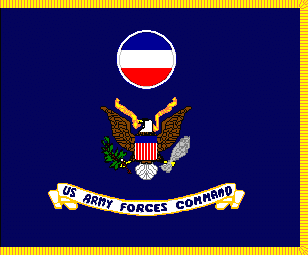
FORSCOM Flag
|
US Army Forces Command
Forces Command controls all US Army forces, Active, Reserve and National Guard, in the continental United States. Its principal mission is to maintain these forces in a deployable status according to current war plans. FORSCOM, as it is commonly known, has a secondary mission of continental defense. Some other Major Army Commands are Training and Doctrine Command and U.S. Army Europe.
Major commands of the US Army have flags with a field of "national flag" blue and yellow fringe. The Coat of Arms of the US, in proper colors (minus the crest) is centered between the command's shoulder sleeve insignia above and a designation scroll below.
|
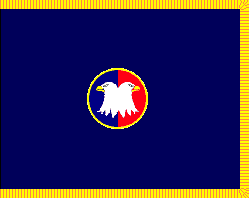
USARC Flag
|
US Army Reserve Command
USARC is broadly responsible for peacetime command and control of USAR units. It is also responsible, under FORCOM, for USAR organization, training and mobilization. The two-star general who commands USARC is also the Chief, Army Reserve.
Organizational Flag, US Army Reserve Command. "Designated Commands" of the Army, of which USARC is one, have flags with a "national flag" blue field, yellow fringe, and the command's shoulder sleeve insignia centered.
|
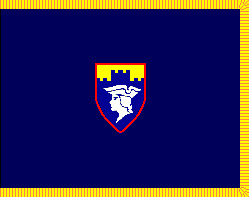
7th ARCOM Flag
|
7th Army Reserve Command
The 7th ARCOM is headquartered in Germany. Many of the civilian employees of the US Army in Germany are Army Reservists.
ARCOM's have organizational flags with a national flag blue field, yellow fringe, and the shoulder sleeve insignia (SSI), in proper colors, centered. Its SSI symbolizes the command's role: the shield shape and the battlements represent the European defense mission, and the Minuteman is the symbol of the USAR.
|
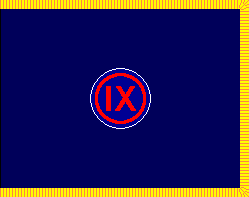
9th RSC Flag
|
9th Army Regional Support Command
The peacetime chain of command for USAR units runs from US Army Forces Command through US Army Reserve Command to RSC's and ARCOM's. These headquarters units are responsible for command and control of USAR units in their geographical areas. When USAR units are called up for active duty, RSC's and ARCOM's mobilize them, prepare them for deployment and dispatch them.
The RSC has an organizational flag with a national flag blue field, yellow fringe, and the shoulder sleeve insignia (SSI), in proper colors, centered. This SSI was formerly used by IX US Army Corps.
|
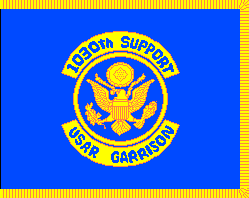
GSU Flag
|
U.S. Army Reserve Garrison Support Unit
This is an example of a flag for a Garrison Support Unit of the Army Reserve. The GSU performs the same kind of housekeeping and support functions for the USAR as the U.S. Army Garrison does for active units.
It has the same pattern of organizational flag - teal blue field with yellow fringe and the insignia for "branch immaterial" between two arcs inscribed with the unit designation.
|
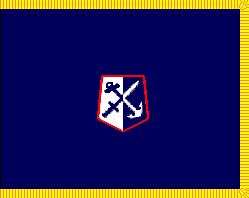
USARITC Flag
|
Rhode Island Army National Guard Troop Command
Exanple of an Army National Guard and/or State National Guard Troop Commands provide peacetime command, control and support for the state's National Guard units. Usually they also plan, command and control purely state missions such as disaster relief and riot control. Troop Commands have flags of the same pattern as those authorized for specified commannds of the Army: "national flag" blue field with yellow fringe and the authorized shoulder sleeve insignia centered.
|
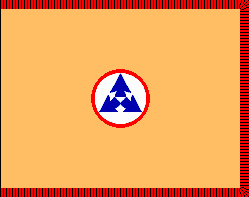
3SC Flag
|
3rd Support Command
U.S. Army numbered commands that are organized under a TOE (Table of Organization and Equipment) are branch-oriented headquarters units at the numbered army or theater of operations level. The commanding general of a signal command, for instance, would be the army/theater's chief signal officer. Organizational flags for these units have a field in the primary branch color and fringe in the secondary branch color with the command's shoulder sleeve insignia (SSI) centered in proper colors.
Organizational flag of 3rd Support Command: the branch colors for support units are buff and scarlet. Dimensions are 3 feet at the hoist by 4 feet on the fly plus 2 1/2-inch fringe.
|
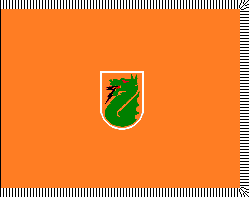
5SC Flag
|
5th Signal Command
Organizational flag of 5th Signal Command: the branch colors for signal corps are orange and white.
|
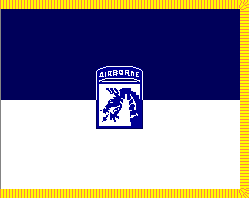
18AC Flag
|
18th Airborne Corps
The XVIII Airborne Corps is the corps of the United States Army designed for rapid deployment anywhere in the world. The mission of the 18th Airborne Corps is to provide a flexible strike capability that can deploy worldwide on short notice without declaration of an emergency. Its headquarters are at Fort Bragg, North Carolina.
The Organizational Flag of the XVIII Airborne Corps is a horizontal bicolor, "national flag" blue over white, with yellow fringe and the corps' shoulder sleeve insignia centered. Most corps SSI are blue and white.
|
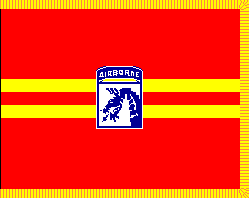
18th Airborne Corps Artillery Flag
|
XVIII Airborne Corps Artillery
Stationed at Fort Bragg, the XVIII Airborne Corps Artillery controls artillery support and units asigned to any XVIII Airborne Corps deployment.
Their Organizational Flag is similar to the flags for division artillery, but with central horizontal yellow-red-yellow stripes instead of a solid yellow stripe, yellow fringe, and the corps SSI centered.
|
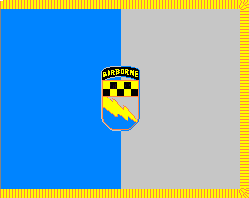
525th Military Intelligence
|
525th Military Intelligence Brigade
Organizational Flag, 525th Military Intelligence Brigade (Airborne). The MI branch colors are oriental blue and silver gray. The 525th MI Brigade is an Active Army unit stationed at Fort Bragg, NC. Its subordinate units consist of two MI battalions and an aviation (helicopter) battalion. The brigade is assigned to the XVIII Airborne Corps.
|

HHC Flag
|
Headquarters Company, 18th Airborne Corps
Headquarters Company, 18th Airborne Corps has a guidon similar to the corps' organizational flag - the standard pattern for corps, blue over white, with the corps' shoulder sleeve insignia centered.
|
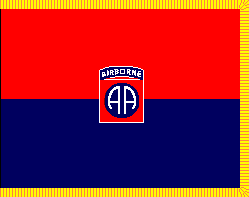
82nd Airborne
|
82nd Airborne Division
The 82nd Airborne Division is an active airborne infantry division of the United States Army specializing in parachute landing operations. Based at Fort Bragg, North Carolina, the 82nd Airborne Division is the primary fighting arm of the XVIII Airborne Corps.
|
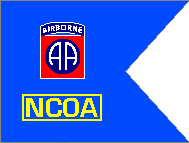
NCOA Guidon
|
82nd Airborne Division Non-Comissioned Officers Academy Guidon
This is the guidon of the 82nd Airborne Division's Noncommissioned Officer Academy at Ft. Bragg, North Carlina. All enlisted soldiers are required to attend an NCOA course before they can be promoted to a NCO rank or being advanced to a higher NCO rank.
U.S. Army NCO academies similar to this one are affiliated with various units, centers, schools, etc. Those affiliated with these units all have teal blue guidons with the shoulder sleeve insignia in proper colors above the letters NCOA in yellow, within a yellow frame.
|
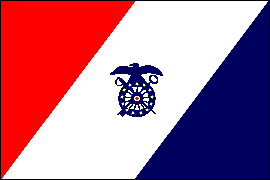
ATS Flag
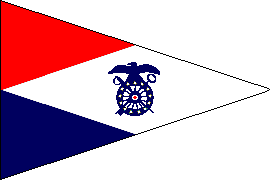
ATS Vessel Pennant
|
Army Transport Service
The U.S. Army Transport Service (part of the Quartermaster Corps) operated ships for the transport of units to overseas locations. These ships flew the National Ensign and Union Jack, and were also authorized a distinctive flag of diagonal red, white and blue stripes with the branch insignia of the Quartermaster Corps centered. Proportions were 2:3 and the flag was made in three sizes. Source: the 1923 and 1931 editions of AR 260-10
U.S. Army: Quartermaster Corps Pennant (1923) Per the 1923 edition of AR 260-10, vessels operated by the Quartermaster Corps, other than ships of the Army Transport Service, flew a triangular red, white and blue pennant with the branch insignia of the Quartermaster Corps centered in the white diamond-shaped portion. This pennant was made of bunting in two sizes: 4-foot hoist by 6-foot fly and 2-foot hoist by 3-foot fly. This pennant is not described in the 1931 edition of the regulation, so it was apparently abolished at some prior time.
|
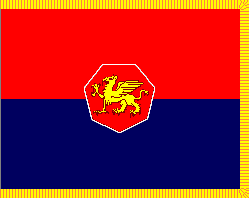
108th IT Division Flag
|
108th Division (Institutional Training)
The 108th Division (IT) is a training division that is part of the Army Reserve. "IT" stands for "Institutional Training," and divisions of this type have a dual role. In peacetime they carry out a major portion of the continuation training required for members of the Army Reserve and Army National Guard, e.g. NCO courses, battle staff training, etc. Upon mobilization, they would also provide initial entry training and advanced individual training as required to support the Army's buildup to war strength.
The design of the flag is the same as for infantry and airborne divisions: scarlet over "national flag" blue with yellow fringe and the division's shoulder sleeve insignia centered. Brigades of the division follow the same pattern as the brigade flags of combatant divisions.
|
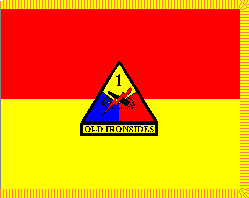
1st Armored Flag
|
1st Armored Division
The 1st Armored Division is the sole cavalry division still active, and stationed in Germany.
Red over yellow denotes armored and cavalry divisions; in fact, the 1st cavalry division is organized like an armored division, but with many of its subordinate units drawn from the cavalry arm.
|
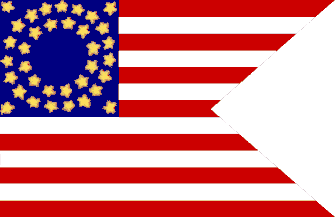
Cavalry Guidons
|
Cavalry Guidons
The Cavalry Guidon was a pennant shaped flag with two rows of stars circled in the canton. The U.S. Cavalry used these guidons during the Civil War and the Plains Indian Wars. The cavalry was the last branch of the military to ever officially carry the Stars and Stripes in battle.
In 1944, Army Regulations added the practice of placing the battalion or squadron number centered within the star circles in the canton. These guidons are still used as ceremonial flags.
|

"Buffalo Soldiers" Guidon
|
I Company/Ninth Cavalry
Guidon
This is the guidon that was carried by the U.S. 9th Cavalry Regiment, Company I during the Civil War. After the Civil War, the 9th and 10th Cavalry regiments were made up of black soldiers and white officers. They were nicknamed the "Buffalo Soldiers" by the Indians because of their fierce fighting qualities and the texture of their skin and hair.
Today U.S. Army cavalry regiments, armored recon, and air cavalry still use similar red-over-white guidons with the regimental number over the troop letter.
|
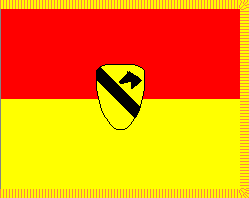
1st Cav Flag
|
1st Cavalry Division
The First Cavalry Division is the only U.S. Army cavalry division to have seen action in modern times. During World War II it served in the Pacific; though designated as a cavalry division and composed of cavalry regiments, it was functionally an infantry division. During the Vietnam War, the division was designated the 1st Cavalry Division (Airmobile), i.e. a helicopter-mobile infantry division. Today, it is organized as an armored division.
Like armored divisions, the 1st Cav's organizational flag is a horizontal bicolor, red over yellow, with yellow fringe and the division's shoulder sleeve insignia centered. The organizational flags of the division's organic brigades also follow the pattern for armored divisions
|
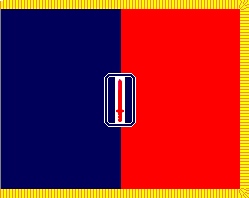
193rd Infantry Flag
|
193rd Infantry Brigade
The Organizational Flag of the 193rd Infantry Brigade was organized as a separate brigade and, like most such units, had a rectangular shoulder sleeve insignia with rounded ends. Many of these separate infantry brigade insignias featured a bayonet. White piping around the insignia provides contrast with the field of the flag.
|
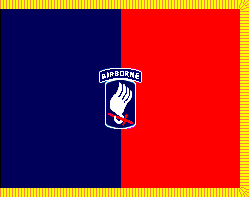
173rd Airborne Flag
|
173rd Airborne Brigade
The Organizational flag of the 173rd Airborne Brigade (Separate). U.S. Army separate airborne and infantry brigades are "brigade battle groups." In addition to the three airborne infantry or infantry battalions found in brigades of divisions, they contain a field artillery battalion, a combat engineer company and various other support units. They are authorized their own shoulder sleeve insignia (SSI), which appear on their organizational flags. The flags are similar to those for brigades of divisions but the order of the vertical stripes is reversed, with national flag blue rather than scarlet at the hoist. Since separate brigades are not organic to any higher formation, no numerals appear on their flags.
|
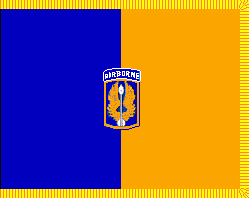
18th Aviation Flag
|
18th Aviation Brigade
Organizational Flag, 18th Aviation Brigade. Ultramarine blue and golden orange are the branch colors for U.S. Army Aviation. The 18th Aviation Brigade is assigned to the XVIII Airborne Corps, which is why the insignia on the flag includes the Airborne tab.
|
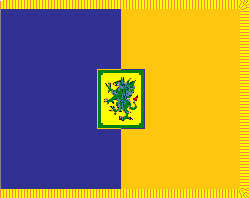
415th Chemical Flag
|
415th Chemical Brigade
Organizational Flag, 415th Chemical Brigade. The Chemical Corps branch colors are cobalt blue and golden yellow. The 415th is a recently activated U.S. Army Reserve unit; previously it was a group. It has units throughout the Midwest. Its missions are chemical recon, detection, defense and decontamination.
The 415th Chemical Brigade has a heagquarters Guidon which follows the same basic pattern and colors as the brigade's organizational flag, but with swallow tails.
|
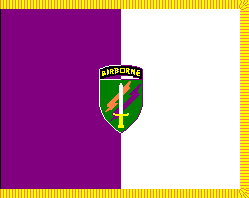
309th Civil Affairs Flag
|
309th Civil Affairs Brigade
Organizational Flag, 309th Civil Affairs Brigade (Airborne) (USAR). Purple and white are the Civil Affairs branch colors. The 309th is an Army Reserve unit headquartered in Homewood, IL; it has the airborne tab above its SSI because it is allocated to the XVIII Airborne Corps.
The 309th Civil Affairs Brigade has a heagquarters Guidon which follows the same basic pattern and colors as the brigade's organizational flag, but with swallow tails.
|
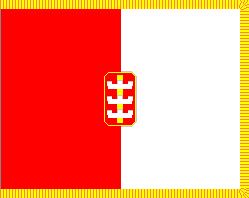
130th Engineering Flag
|
130th Engineering Brigade
Organizational Flag, 130th Engineer Brigade: For contrast with the field of the flag, the insignia is edged with yellow piping.
|
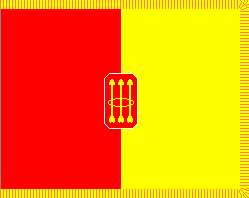
30th Field Artillery Flag
|
30th Field Artillery Brigade
Organizational Flag, 30th Field Artillery Brigade: Scarlet and red are the colors of the field artillery. Many separate brigade shoulder sleeve insignia are, like this one, rectangular with slightly rounded ends. There are numerous exceptions, however. The insignia is edged with white piping for contrast with the field of the flag.
|
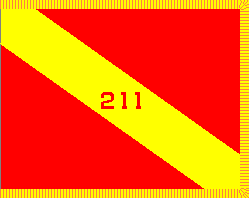
211th Field Artillery Flag
|
211th Field Artillery Group
211th Field Artillery Group. Scarlet and yellow are the Field Artillery branch colors. The 211th FA Group was activated in 1942 when the 211th FA Regiment was broken up into independent battalions; in the 1950's it was inactivated when regimental identities were reestablished in the FA branch. Flags in the same colors are used by Air Defense Artillery groups.
|

Alexander Hamilton Battery
|
Headquarters Battery, 1st Battalion, 5th Field Artillery
The "Alexander Hamilton Battery", the Headquarters Battery, 1st Battalion, 5th Field Artillery, is the oldest unit in the Regular Army. It is the direct descendant of the battery commanded by Alexander Hamilton during the American Revolution. In 1882, this unit was authorized to bear this distinctive guidon divided horizontally red over white, with a yellow embroidered device in the upper hoist consisting of the artillery corps device and the unit designation, all surrounded by a circle of stars. In addition, the guidon was embroidered with the date of the battery's establishment, Hamilton's name, a battle honor for Long Island (1776), and other commemorative information.
The current version of this guidon was displayed outside the Army Chief of Staff's office at the Pentagon for years, but has now been removed. Unlike other guidons of active Army units, it was made of rayon banner cloth rather than bunting and had a golden-yellow fringe.
|
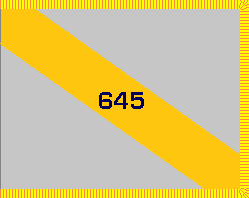
645th Finance Flag
|
645th Finance Group
Organizational Flag, 645th Finance Group. Groups are branch-oriented headquarters units similar to but smaller in size than brigades; they control a variable number of battalions and separate companies/detachments. Unlike separate brigades, groups are not authorized a shoulder sleeve insignia and so their flags are of a simple pattern: field in the first-named branch color, diagonal stripe from upper hoist to lower fly in the second-named branch color and numerical designation centered on the stripe in (usually) the first-named branch color. The fringe is yellow for all group flags. The branch colors for the Finance Corps are silver gray and golden yellow; the numeral on the stripe is "national flag" blue rather than golden yellow to make it more visible.
|
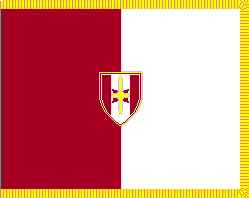
44th Medical Flag
|
44th Medical Brigade
Organizational Flag, 44th Medical Brigade: Maroon and white are the colors of the Army Medical Department. The insignia has a yellow piping for contrast with the field of the flag.
|
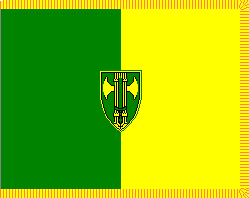
18th MP Flag
|
18th Military Police Brigade
Organizational Flag, 18th Military Police Brigade. Green and yellow are the MP branch colors. The 18th MP Brigade is an Active Army unit stationed in Germany. Its subordinate units consist of two MP battalions and a number of companies, detachments, etc
|
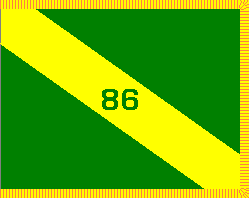
86th MP Flag
|
86th Military Police Group
86th Military Police Group. Green and yellow are the branch colors of the Corps of Military Police. The 86th Military Police Group served in Vietnam and was inactivated in the 1970's.
|
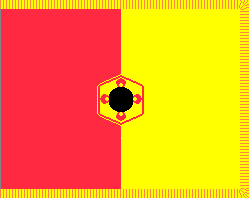
57th Ordnance Flag
|
57th Ordnance Brigade
Organizational Flag, 57th Ordnance Brigade. Branch colors are crimson and yellow. The shoulder sleeve insignia features a variant of the branch badge of the Ordnance Corps, a flaming grenade. The 57th was at one time an Active Army unit stationed in Germany.
The 57th Ordnance Brigade has a heagquarters Guidon which follows the same basic pattern and colors as the brigade's organizational flag, but with swallow tails.
|
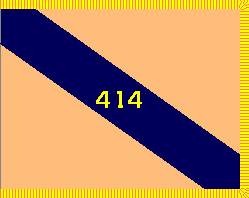
414th QM Flag
|
414th Quartermaster Group
Organizational Flag, 414th Quartermaster Group. Buff and light blue are the Quartermaster branch colors. The group flag for QM units, however, has a buff field with a "national flag" blue stripe and yellow numerals, the reason being that a light blue stripe with buff numerals would provide insufficient contrast against the buff field.
|
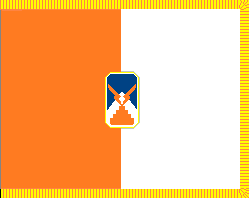
7th Signal Flag
|
7th Signal Brigade
Organizational Flag, 7th Signal Brigade: The colors of the Signal Corps are Orange and white. The insignia has a yellow piping for contrast with the field of the flag.
|

Signal Vessel Flag
|
Signal Corps Vessel Flag
Signal Corps - The Signal Corps operates a number of communications-related vessels. They display an orange flag with the corps device in white, two crossed signal flags surmounted by a flaming torch. The sizes are the same as for the Transportation Corps. Source: AR 840-10.
|
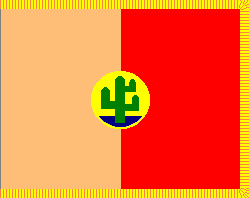
103rd Support Flag
|
103rd Support Brigade
The 103rd Support Brigade is currently an Army Reserve unit (unless it, too, has fallen victim to defense budget cuts). All separate brigades of the U.S. Army have flags of two colors, divided vertically, with the unit's shoulder sleeve insignia centered. Buff and scarlet are the colors used for flags of separate support brigades. These units provide command and control for a variety of combat service support units -- administrative, supply, ordnance, medical, etc.
It uses the same shoulder sleeve insignia as the WW II-era 103rd Infantry Division.
The 103rd Support Brigade has a heagquarters Guidon which follows the same basic pattern and colors as the brigade's organizational flag, but with swallow tails.
|
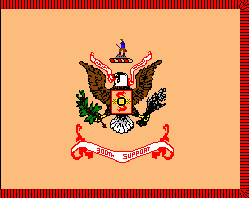
300th Support Flag
|
300th Support Battalion
The Organizational Color of the 300th Support Battalion (Corps), a U.S. Army Reserve unit based in Lafayette, Indiana. The color is buff with scarlet fringe, these being the colors for support units.
|
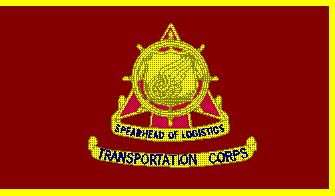
Transportation Corps Regiment
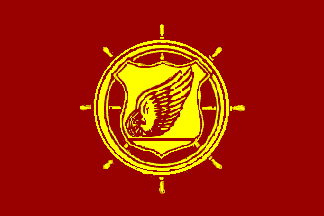
Transportation Corps Vessel Flag
|
Army Transportation Corps
The flag of my regiment, the U.S. Army Transportation Corps Regiment. The flag is brick red with a gold fringe. The crest depicts a ships wheel, a highway sign, a winged wheel on a rail-representing the different forms of transportation - all superimposed on an arrowhead brick red and gold-alluding to the regiment's motto "Spearhead of Logistics"-which appears in a gold scroll with blue letters.
Vessel Flag, Transportation Corps, U.S. Army. Army-operated ships and watercraft fly branch-specific vessel flags in addition to the National Ensign. For some reason, they not only come in several sizes but in two different proportions: 4:5 and 2:3; I have illustrated the latter. Vessel flags are in branch colors, in this case brick red and golden yellow for the Transportation Corps. The insignia is the branch badge as worn on the lapels of the Class "A" uniform jacket by commissioned officers. Most Army vessels are operated by either the Transportation Corps or the Corps of Engineers, though AR 840-10 also illustrates a vessel flag for the Signal Corps.
|

425th Transportation Flag
|
425th Transportation Group
425th Transportation Group. Brick red and golden yellow are the branch colors of the Transportation Corps. The 425th Transportation Group, an Army Reserve unit, was upgraded to a brigade in the 1970's and inactivated in 1992.
|
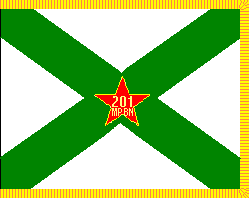
201st MP Flag
|
201st Military Police Battalion
The MP Corps is a "whole-branch" regiment; this color represents the Corps as a whole. Green and yellow are the MP branch colors. The crest consists of crossed flintlock pistols, the MP branch insignia. MP battalions have similar colors with their own coats of arms, and their unit designation on the scroll
|
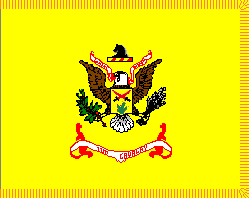
11th Armored Cavalry Flag
|
11th Armored Cavalry Regiment
The Organizational Color of the 11th Armored Cavalry Regiment. Like the colors of armor regiments and battalions, those for cavalry regiments and squadrons have a yellow field and fringe with scarlet inscriptions and scroll outlines. Squadrons of cavalry regiments have identical colors with the addition of a squadron numeral in the upper fly.
The 11th Armored Cav is a Regular Army unit. It is a separate brigade-sized formation with its own artillery, aviation and support units. These full armored cavalry regiments are attached to corps headquarters; separate armored cavalry squadrons form the recon/scout elements of armored and mechanized infantry divisions.
|
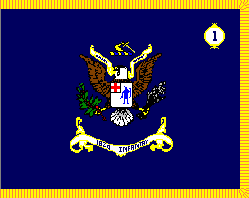
1st Battalion Flag
|
182nd Infantry, 1st Battalion
The base color for infantry colors is "national flag blue" (dark blue) instead of light blue, which is actually the infantry's first named branch color. This is a "tradition" feature, dark blue having been used for many historic U.S. Army colors.
The 1st Battalion, 182nd Infantry is reputed to be the oldest military unit in the United States. It traces its ancestry back to the colonial militia bands of seventeenth-century Massachusetts and has, under one name or another, been in continuous existence since that time. Today it is a unit of the Massachusetts Army National Guard. The 182nd's coat of arms features an Indian similar to the one on the Massachusetts state flag, while the St. George's Cross in the canton recalls the regiment's origins as a colonial militia unit. The crest is the Massachusetts "Arm of God" (all National Guard units use a state crest with their coats of arms). The regimental motto translates from the Latin to "We Guard Our Ancient Honors."
|
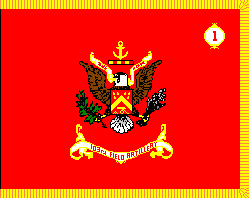
103rd Regimental Colors

103rd Brigade Flag
|
103rd Field Artillery
Organizational Color, 1st Battalion, 103rd Field Artillery. I recently did a little research and discovered that the 1-103 FA still exists as a unit of the Rhode Island Army National Guard. Scarlet and yellow are the FA branch colors. As a National Guard unit, the 1-103 FA has a State crest on its color, in this case an anchor for Rhode Island. The regimental motto is PLAY THE GAME.
Organizational Flag, 103rd Field Artillery Brigade. This brigade is also a unit of the Rhode Island Army National Guard; in fact, it is the 1-103 FA's controlling headquarters. Fittingly, the insignia features an anchor over crossed cannons.
|
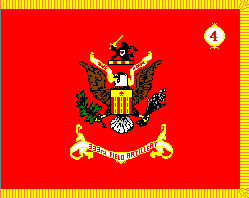
333rd Field Artillery Flag
|
333rd Field Artillery, 4th Battalion
Regiments and battalions of the U.S. Army have organizational colors of a standard pattern. This is a field artillery color (in fact, the color of my old Army Reserve battalion). The field of the color is the first named branch color which, for artillery, is red. The fringe and scroll outlines are the second named branch color, in this case yellow. The U.S. eagle bears on its breast the shield of the regimental coat of arms; above its head is the crest of the arms (a Belgian lion; the battalion received a Presidential unit citation for action at Bastogne, 1944). In its beak the eagle grasps a scroll bearing the regimental motto (too small to read in this GIF, but it's "Three Rounds"). The battalion number appears in the upper fly and the regimental title on a scroll below the eagle.
|
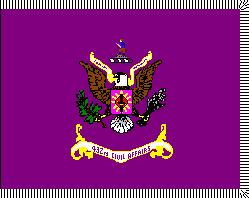
432nd Civil Affairs Flag
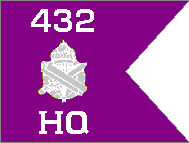
432nd HQ Pennant
|
432nd Civil Affairs Battalion
Organizational Color, 432nd Civil Affairs Battalion (USAR). The standard pattern color for Separate battalions in the purple and white branch colors. The 432nd is a battalion of the 309th CA Brigade; it is headquartered in Green Bay, WI. The battalion motto is BRINGING ORDER TO CHAOS. Civil Affairs brigades and battalions are new formation types in the U.S. Army; previously the branch was organized on a group/company & detachment basis. Almost all Army CA assets are in the USAR. The 309th and 432nd have seen much active service in recent years, especially in Bosnia and Haiti.
|
Flag
|
Flag
|
Flag
|
Flag
|
Flag
|
Flag
|
Flag
|
Flag
|
Flag
|
Flag
|
Flag
|
Flag
|
Flag
|
Flag
|
Flag
|
Flag
|
Flag
|
Flag
|
Flag
|
Flag
|
Flag
|
Flag
|